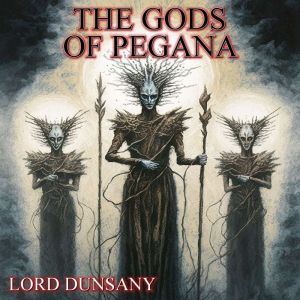

The Gods Of Pegana
Author: Lord Dunsany
Narrator: Matthew Schmitz
Unabridged: 1 hr 48 min
Format: Digital Audiobook Download
Publisher: Altrusian Grace Media
Published: 02/23/2023
Categories: Fiction, Fantasy, Young Adult Fiction, Dragons


Author: Lord Dunsany
Narrator: Matthew Schmitz
Unabridged: 1 hr 48 min
Format: Digital Audiobook Download
Publisher: Altrusian Grace Media
Published: 02/23/2023
Categories: Fiction, Fantasy, Young Adult Fiction, Dragons
Lord Dunsany was born in London in 1878, the scion of an Anglo-Irish family that could trace its ancestry to the twelfth century. In 1905 he self-published The Gods of Pegana, and its critical and popular success impelled the publication of numerous other collections of short stories, including A Dreamer's Tales, The Book of Wonder, and The Last Book of Wonder. Dunsany also distinguished himself as a dramatist, and his early plays-collected in Five Plays and Plays of Gods and Men-were successful in Ireland, England, and the United States. Dunsany was seriously injured during the Dublin riots of 1916, and he also saw action in World War I as a member of the Coldstream Guards.
In the 1920s Dunsany began writing novels, among them The King of Elfland's Daughter and The Blessing of Pan. He also wrote many tales of the loquacious clubman Joseph Jorkens, eventually collected in five volumes. His later plays include If, Plays of Near and Far, Seven Modern Comedies, and Plays for Earth and Air. By the 1930s, encouraged by W. B. Yeats and others to write about his native Ireland, he produced The Curse of the Wise Woman, The Story of Mona Sheehy, and other novels. His later tales were gathered in The Man Who Ate the Phoenix and The Little Tales of Smethers, but many works remain uncollected. Lord Dunsany died at Dunsany Castle in County Meath, Ireland, in 1957. He is recognized as a leading figure in the development of modern fantasy literature, influencing such writers as J. R. R. Tolkien, H. P. Lovecraft, and Ursula K. Le Guin.
A short but ambitious book that attempts to create an entire mythology. Its style, rooted in the fin de siècle', and filled with faux archaism, is charmingly quaint, and its metaphors evoke meditations upon the nature of time and death, dream and creation. This was a favorite book of H.P. Lovecraft,......more
The Gods of Pegana is an invented pantheon. This slim book by Lord Dunsany has been tremendously influential, having inspired illustrious personages such as H.P.Lovecraft and J.R.R.Tolkien. And the original illustrations by Sidney Sime are classics by themselves. I have been wanting to read this book......more
Om nom nom. I ate this one up - the language is gorgeous and controlled, the myths archetypally resonant yet fresh and original... yummy fantasy tales. My favorite tale is the myth of the Trogool: Also, Sidney Sime's pictures are gorgeous; get a version with his art (or at least look it up online).......more
"وعلى جانبي الطريق رأيت البشر يذبحون البشر، وكانت نتيجة مذبحتهم أعظم من مذبحة أي طاعون من أفعال الآلهة الشريرة. وثارت المدن وروُدمت منازلها بالتراب، وعادة الصحراء مجددا إلى طبيعتها، لتغطي وتخفي آخر أثر لهؤلاء الذين قد أقلقوا سكينتها. وما زال البشر يذبحون البشر. حتى وصلت إلى زمن لم يعد البشر يضعون فيه ن......more
Not for everyone, but definitely for me. This isn't so much a collection of short stories as a collection of vignettes and prose poems that, taken together, create a kind of artificial mythology -- kind of a precursor to The Silmarillion but without as much narrative linkage and structure. But the e......more